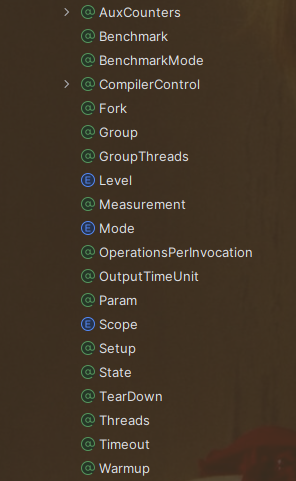JMH – Java基准测试
官方资源#
应用场景#
- 对要使用的数据结构不确定,不知道谁的性能更好
- 对历史方法代码重构,要评判改造之后的性能提升多少 (我要做的场景)
- 想准确地知道某个方法需要执行多长时间,以及执行时间和输入之间的相关性
- 对比接口不同实现在给定条件下的吞吐量
- 查看多少百分比的请求在多长时间内完成
背景限制(防杠指南)#
- 业务场景?
因为当前项目是接手比较老的项目,已经有成熟业务在跑,原先的生成模型是nextByCalendarAndRandom, 序号生成是采用两位随机数,然后随机数产生了冲突,一毫秒内产生的两个随机数有冲突, - 为什么不直接使用 snowflake?
原先的生成逻辑 6(商户号) + 15(yyMMddHHmmssSSS 最大长度,可能比15小) + 2(随机数) = 23 (最大长度)
如果使用雪花算法,则 6 + 19 = 25 (最大长度),且现在业务方较多,不确定对方是否有限制该字段长度,再就是如果对雪花算法进行裁剪,也不能保证肯定不会出现冲突,经衡量过后,暂时不使用雪花算法,后续业务方能确定长度没有问题,就可以升级 - 这个算法不是分布式的,如果是两台服务器,则出现冲突的可能性就变大了
是的,如果两台服务同时运行,然后又同时有请求进来,就有很大的可能性出现冲突,但现在的业务状况是单体架构,只不过做了主备服务,主服务宕机,备份才会启动,暂时不会两台服务同时启动 - 那如果采用
nextByCalendarAndAtomicInteger自增,就表示一毫秒最大只有100个请求能进来?超过就肯定会冲突?
是的,这个也是业务决定的,如果我们当前的业务量超过每毫秒超100,那问题可能不是我这里的冲突了,服务会率先被压垮 - 最终的业务采用什么方法?
使用了nextByLocalDateTimeAndAtomicInteger方法,也有每毫秒超100必定重复的限制
引用依赖#
<dependency>
<groupId>org.openjdk.jmh</groupId>
<artifactId>jmh-core</artifactId>
<version>1.35</version>
</dependency>
<dependency>
<groupId>org.openjdk.jmh</groupId>
<artifactId>jmh-generator-annprocess</artifactId>
<version>1.35</version>
</dependency>
测试代码#
@UtilityClass
public class IdWork {
@Deprecated
public static String nextByCalendarAndRandom(String merchantNo) {
Calendar now = Calendar.getInstance();
long random1 = Math.round(Math.random() * 9);
long random2 = Math.round(Math.random() * 9);
String timestamp = (now.get(Calendar.YEAR) + "").substring(2)
+ (now.get(Calendar.MONTH) + 1)
+ now.get(Calendar.DAY_OF_MONTH)
+ now.get(Calendar.HOUR_OF_DAY)
+ now.get(Calendar.MINUTE)
+ now.get(Calendar.SECOND)
+ now.get(Calendar.MILLISECOND);
return merchantNo + timestamp + random1 + random2;
}
@Deprecated
public static String nextByLocalDateTimeAndRandom(String merchantNo) {
LocalDateTime now = LocalDateTime.now();
long random1 = Math.round(Math.random() * 9);
long random2 = Math.round(Math.random() * 9);
String timestamp = (now.getYear() + "").substring(2)
+ now.getMonthValue()
+ now.getDayOfMonth()
+ now.getHour()
+ now.getMinute()
+ now.getSecond()
+ (now.getNano() / 1000000);
return merchantNo + timestamp + random1 + random2;
}
@Deprecated
public static String nextByCalendarAndAtomicInteger(String merchantNo) {
Calendar now = Calendar.getInstance();
String timestamp = (now.get(Calendar.YEAR) + "").substring(2)
+ (now.get(Calendar.MONTH) + 1)
+ now.get(Calendar.DAY_OF_MONTH)
+ now.get(Calendar.HOUR_OF_DAY)
+ now.get(Calendar.MINUTE)
+ now.get(Calendar.SECOND)
+ now.get(Calendar.MILLISECOND);
return merchantNo + timestamp + getSeqNo();
}
@Deprecated
public static String nextByLocalDateTimeAndAtomicInteger(String merchantNo) {
LocalDateTime now = LocalDateTime.now();
String timestamp = (now.getYear() + "").substring(2)
+ now.getMonthValue()
+ now.getDayOfMonth()
+ now.getHour()
+ now.getMinute()
+ now.getSecond()
+ (now.getNano() / 1000000);
return merchantNo + timestamp + getSeqNo();
}
public static String nextBySnowflake(String merchantNo) {
return merchantNo + IdGenerator.next();
}
private static AtomicInteger seqNo = new AtomicInteger(1);
private static String getSeqNo() {
int curSeqNo = seqNo.getAndIncrement();
if (curSeqNo > 99) { // 重置,也可以取模
seqNo = new AtomicInteger(1);
}
if (curSeqNo < 10) {
return "0" + curSeqNo;
}
return curSeqNo + "";
}
public static void main(String[] args) {
String next1 = IdWork.nextByCalendarAndRandom("900087");
System.out.println(next1);
String next2 = IdWork.nextByLocalDateTimeAndRandom("900087");
System.out.println(next2);
String next3 = IdWork.nextByCalendarAndAtomicInteger("900087");
System.out.println(next3);
String next4 = IdWork.nextByLocalDateTimeAndAtomicInteger("900087");
System.out.println(next4);
String next5 = IdWork.nextBySnowflake("900087");
System.out.println(next5);
}
}
public class IdTest {
@Benchmark
public String getIdBySnowflake() {
return IdWork.nextBySnowflake("900087");
}
@Benchmark
public String nextByCalendarAndRandom() {
return IdWork.nextByCalendarAndRandom("900087");
}
@Benchmark
public String nextByLocalDateTimeAndRandom() {
return IdWork.nextByLocalDateTimeAndRandom("900087");
}
@Benchmark
public String nextByCalendarAndAtomicInteger() {
return IdWork.nextByCalendarAndAtomicInteger("900087");
}
@Benchmark
public String nextByLocalDateTimeAndAtomicInteger() {
return IdWork.nextByLocalDateTimeAndAtomicInteger("900087");
}
public static void main(String[] args) throws RunnerException {
// 吞吐量
// Options opt = new OptionsBuilder()
// .include(IdTest.class.getSimpleName())
// .mode(Mode.Throughput)
// .forks(1)
// .build();
// 平均耗时
Options opt = new OptionsBuilder()
.include(IdTest.class.getSimpleName())
.mode(Mode.AverageTime)
.timeUnit(TimeUnit.NANOSECONDS)
.forks(1)
.build();
new Runner(opt).run();
}
// 吞吐量
// Benchmark Mode Cnt Score Error Units
// IdTest.getIdBySnowflake thrpt 5 4070403.840 ± 11302.832 ops/s
// IdTest.nextByCalendarAndAtomicInteger thrpt 5 4201822.821 ± 177869.095 ops/s
// IdTest.nextByCalendarAndRandom thrpt 5 4085723.001 ± 47505.309 ops/s
// IdTest.nextByLocalDateTimeAndAtomicInteger thrpt 5 5036852.390 ± 153313.836 ops/s
// IdTest.nextByLocalDateTimeAndRandom thrpt 5 5199148.189 ± 405132.888 ops/s
// 平均耗时
// Benchmark Mode Cnt Score Error Units
// IdTest.getIdBySnowflake avgt 5 245.739 ± 0.302 ns/op
// IdTest.nextByCalendarAndAtomicInteger avgt 5 239.174 ± 4.244 ns/op
// IdTest.nextByCalendarAndRandom avgt 5 251.084 ± 5.798 ns/op
// IdTest.nextByLocalDateTimeAndAtomicInteger avgt 5 197.332 ± 0.779 ns/op
// IdTest.nextByLocalDateTimeAndRandom avgt 5 212.105 ± 1.888 ns/op
}
概念理解#
| 类型 | 作用域 | 描述 | 备注 |
|---|---|---|---|
| Benchmark | ElementType.METHOD | 最重要的注解,标记需要执行的方法 | |
| BenchmarkMode | ElementType.METHOD, ElementType.TYPE | 统计的维度,有吞吐量,平均耗时,也可以组合使用 | |
| Fork | ElementType.METHOD, ElementType.TYPE | 复制多个进程来执行方法,每轮默认Iteration循环5次,如果fork 3,则会执行3*5 次,一般默认值1就可以 | |
| Measurement | ElementType.METHOD, ElementType.TYPE | 方法控制:循环次数,每次循环时间以及对应的时间单位 | |
| Warmup | ElementType.METHOD,ElementType.TYPE | 预热,避免系统冷启动导致的性能测试不准 | |
| OutputTimeUnit | ElementType.METHOD, ElementType.TYPE | 输出时间单位,默认是秒 | |
| Param | ElementType.FIELD | 可以指定遍历参数,针对特殊字段测试不同的性能 | |
| Setup | ElementType.METHOD | 启动类设置,类似 junit Before类型注解 | |
| TearDown | ElementType.METHOD | 销毁类设置,类似junit After类型注解,一般用于销毁池化的资源 | |
| Threads | ElementType.METHOD,ElementType.TYPE | ||
| Timeout | ElementType.METHOD,ElementType.TYPE | ||
| AuxCounters | ElementType.TYPE | 辅助计数器,可以统计 @State 修饰的对象中的 public 属性被执行的情况 | |
| Group | ElementType.METHOD | ||
| GroupThreads | ElementType.METHOD | ||
| CompilerControl | ElementType.METHOD, ElementType.CONSTRUCTOR, ElementType.TYPE | 内联扩展是一种特别的用于消除调用函数时所造成的固有时间消耗方法,这里用来控制方法或类是否内联 | |
| OperationsPerInvocation | ElementType.METHOD, ElementType.TYPE |
BenchmarkMode 执行模式(可以多个组合执行)
| 类型 | 描述 |
|---|---|
| Throughput | 每段时间执行的次数,一般是秒 |
| AverageTime | 平均时间,每次操作的平均耗时 |
| SampleTime | 在测试中,随机进行采样执行的时间 |
| SingleShotTime | 在每次执行中计算耗时 |
| All | 所有模式 |
// 常用的注解
@BenchmarkMode({Mode.Throughput,Mode.AverageTime})
@OutputTimeUnit(TimeUnit.NANOSECONDS)
@Warmup(iterations = 3, time = 1, timeUnit = TimeUnit.SECONDS)
@Measurement(iterations = 5, time = 1, timeUnit = TimeUnit.SECONDS)
@Fork(1)
public class BenchmarkTest {
@Benchmark
public long test() {}
}
// 使用 OptionsBuilder 建造者模式构建 Options, 然后在main方法执行,建议使用
Options opt = new OptionsBuilder()
.include(IdTest.class.getSimpleName())
.mode(Mode.AverageTime)
.mode(Mode.Throughput)
.timeUnit(TimeUnit.NANOSECONDS)
.warmupIterations(3)
.warmupTime(TimeValue.seconds(1))
.measurementIterations(5)
.measurementTime(TimeValue.seconds(1))
.forks(1)
.build();
一些提示#
避免循环
JVM会对循环进行优化,这样会导致获取的测试结果不准确。
引用资源#
jmh-java-microbenchmark-harness
jenkov: java-performance
jmh-benchmark-with-examples
Java基准测试工具 —— JMH使用指南
作者:一根会思考的芦苇
出处:https://www.cnblogs.com/javar/p/jmh.html
版权:本作品采用「署名-非商业性使用-相同方式共享 4.0 国际」许可协议进行许可。
记录生活,记录成长。




【推荐】国内首个AI IDE,深度理解中文开发场景,立即下载体验Trae
【推荐】编程新体验,更懂你的AI,立即体验豆包MarsCode编程助手
【推荐】抖音旗下AI助手豆包,你的智能百科全书,全免费不限次数
【推荐】轻量又高性能的 SSH 工具 IShell:AI 加持,快人一步
· TypeScript + Deepseek 打造卜卦网站:技术与玄学的结合
· 阿里巴巴 QwQ-32B真的超越了 DeepSeek R-1吗?
· 【译】Visual Studio 中新的强大生产力特性
· 10年+ .NET Coder 心语 ── 封装的思维:从隐藏、稳定开始理解其本质意义
· 【设计模式】告别冗长if-else语句:使用策略模式优化代码结构